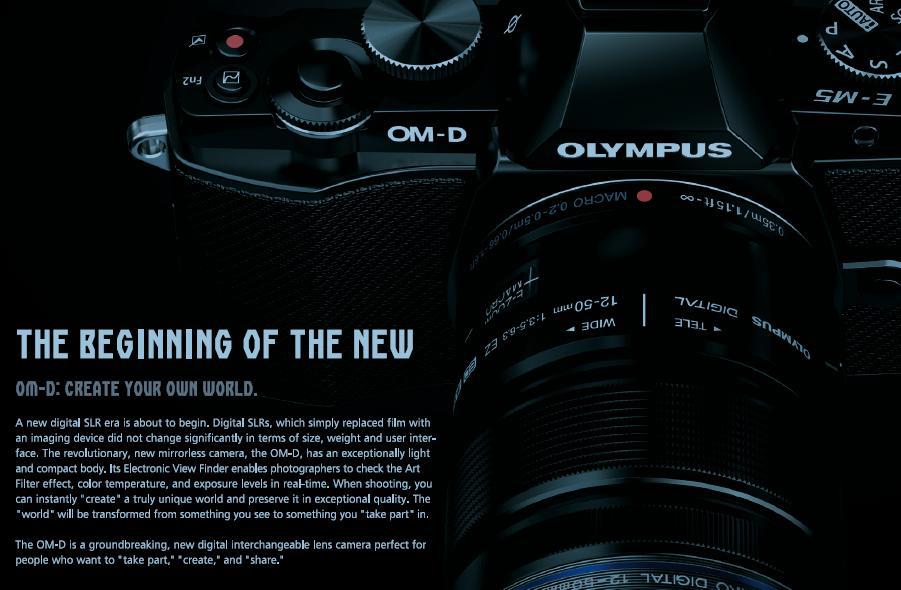Tallying Up the Rumors of the Olympus E-M5 - Part 2
Two more interesting pieces of information about the E-M5 finally dropped down from the Internets and onto the pages of 43rumors. The first is a (more) complete frontal view of the E-M5. The second concerns its so-called "five axis" image stabilization.
The top photo is my OM-4T. The bottom image is alleged to belong to the soon-to-be-released OM-D E-M5 (love all those letters and dashes everywhere, don't you?). The E-M5's design echos that of the OM-4T but not in the details.
Looking at the left top plate (if you're behind the camera) of the OM-4T you'll see the Manual/Auto/Battery Test switch (in the Auto mode), which has no equivalent on the E-M5's top deck. There's obviously no rewind dial on the E-M5, and the combo ISO selection/exposure compensation dial under the rewind on the OM-4T is taken with the PASM dial on the E-M5.
On the side of the camera where the OM-4T has the film wind lever you'll see nothing on the E-M5 except an echo of the film wind in the body design, which makes me wonder if it's there to provide a comfortable rest for the thumb on the photographer's right hand. The OM-4T's frame counter is missing on the E-M5. The only part of the two cameras that look anywhere close to being equivalent are the shutter release and the pentaprism housing. And to have a pentaprism hump on the E-M5 is a bit humorous, considering that the E-M5 is mirrorless and you're looking into the equivalent of the VF-2 EVF.
On the OM-4T that dual position center-off switch around the shutter release looks to be a dial on the E-M5, and there's what appears to be a second dial on the E-M5 where the OM-4T's spot meter controls are located. And of course there's the one huge difference between the OM-4T and the E-M5, the shutter speed ring around the OM-4T's lens mount that's completely missing from the E-M5. Call me picky, but I would have given just about anything for a digital Pen with that same style control on the front of the body.
Looking at the E-M5 I can't help but notice how much thicker the shutter release side of the camera appears to be compared to the Pens. I'm seriously hoping that the body has been thickened a bit to allow for a larger battery for the E-M5. That would be nice to have, as the BLS-1 provides, with all the gegaws running on the E-P2, about 300 to 350 exposures maximum. And very little real time for video. If this is meant to be a more meaningful video camera then the battery capacity and size are going to have to be increased. And I believe it's going to be the most serious video camera Olympus has released yet because of the new image stabilization system that's allegedly being built into the E-M5.
Five Axis Image Stabilization
Five axis stabilization is the concept of providing image stabilization along five of the six degrees of freedom of a rigid body, which in this case is the body of the camera. The forward and back axis refers to the axis perpendicular to the sensor and passing through the center of the lens, and it is not stabilized. Stabilization, if you want to call it that, is being handled by the autofocus of the lens. That leaves the other five axes to be stabilized around the sensor in the camera body.
All current Olympus in-body image stabilization (IBIS) is two axis only. The two axes are up/down and left/right, parallel to the sensor plane. This form of IBIS has been used by Olympus since the E-3 and E-510 cameras were introduced in 2007. It's been used ever since (except in the E-4x0 regular 4/3rds bodies), all the way through the digital Pen series and on through Olympus' latest 'hero' camera for the 4/3rds series, the E-5.
But there's a problem with two axis IBIS, and that's video. Two-axis IBIS doesn't appear to work very well with video, at least not as well as the Canon in-lens image stabilization system, or ILIS.
Canon has for quite some time staunchly championed ILIS as the solution to image stabilization. Canon has added Hybrid IS to its lenses in order to provide image stabilization on at least four of the camera/lens axes; up/down and left-right side-to-side shake, pitch, and yaw. And it appears to work quite well on their current crop of DSLRS supporting video such as the 60D, 7D, and the now-venerable 5DmkII. Not only does it work well for hand-held still photography but for hand-held video capture as well.
What's missing in the Canon ILIS solution is roll about the central axis running through the lens and parallel to the sensor. Olympus has apparently decided to match the Canon ILIS solution and raise them by adding roll stabilization to the Olympus IBIS solution. I'm assuming that Olympus' five axis solution is superior to its current solution, otherwise they wouldn't be going to this much trouble to productize it. And being in-body, this means any lens attached to the E-M5 will benefit from this IBIS solution as it always has, especially for video use.
It's going to be interesting come 8 February.
Update 4 February
Part 1: http://blogbeebe.blogspot.com/2012/02/tallying-up-rumors-of-olympus-e-m5.html
The Final Reveal: http://blogbeebe.blogspot.com/2012/02/tallying-up-rumors-of-olympus-e-m5_04.html
 |
| Olympus OM-4T |
The top photo is my OM-4T. The bottom image is alleged to belong to the soon-to-be-released OM-D E-M5 (love all those letters and dashes everywhere, don't you?). The E-M5's design echos that of the OM-4T but not in the details.
Looking at the left top plate (if you're behind the camera) of the OM-4T you'll see the Manual/Auto/Battery Test switch (in the Auto mode), which has no equivalent on the E-M5's top deck. There's obviously no rewind dial on the E-M5, and the combo ISO selection/exposure compensation dial under the rewind on the OM-4T is taken with the PASM dial on the E-M5.
On the side of the camera where the OM-4T has the film wind lever you'll see nothing on the E-M5 except an echo of the film wind in the body design, which makes me wonder if it's there to provide a comfortable rest for the thumb on the photographer's right hand. The OM-4T's frame counter is missing on the E-M5. The only part of the two cameras that look anywhere close to being equivalent are the shutter release and the pentaprism housing. And to have a pentaprism hump on the E-M5 is a bit humorous, considering that the E-M5 is mirrorless and you're looking into the equivalent of the VF-2 EVF.
On the OM-4T that dual position center-off switch around the shutter release looks to be a dial on the E-M5, and there's what appears to be a second dial on the E-M5 where the OM-4T's spot meter controls are located. And of course there's the one huge difference between the OM-4T and the E-M5, the shutter speed ring around the OM-4T's lens mount that's completely missing from the E-M5. Call me picky, but I would have given just about anything for a digital Pen with that same style control on the front of the body.
 |
| The alleged OM-D E-M5 |
Looking at the E-M5 I can't help but notice how much thicker the shutter release side of the camera appears to be compared to the Pens. I'm seriously hoping that the body has been thickened a bit to allow for a larger battery for the E-M5. That would be nice to have, as the BLS-1 provides, with all the gegaws running on the E-P2, about 300 to 350 exposures maximum. And very little real time for video. If this is meant to be a more meaningful video camera then the battery capacity and size are going to have to be increased. And I believe it's going to be the most serious video camera Olympus has released yet because of the new image stabilization system that's allegedly being built into the E-M5.
Five Axis Image Stabilization
Five axis stabilization is the concept of providing image stabilization along five of the six degrees of freedom of a rigid body, which in this case is the body of the camera. The forward and back axis refers to the axis perpendicular to the sensor and passing through the center of the lens, and it is not stabilized. Stabilization, if you want to call it that, is being handled by the autofocus of the lens. That leaves the other five axes to be stabilized around the sensor in the camera body.
All current Olympus in-body image stabilization (IBIS) is two axis only. The two axes are up/down and left/right, parallel to the sensor plane. This form of IBIS has been used by Olympus since the E-3 and E-510 cameras were introduced in 2007. It's been used ever since (except in the E-4x0 regular 4/3rds bodies), all the way through the digital Pen series and on through Olympus' latest 'hero' camera for the 4/3rds series, the E-5.
But there's a problem with two axis IBIS, and that's video. Two-axis IBIS doesn't appear to work very well with video, at least not as well as the Canon in-lens image stabilization system, or ILIS.
 |
| Canon's Hybrid Image Stabilization |
Canon has for quite some time staunchly championed ILIS as the solution to image stabilization. Canon has added Hybrid IS to its lenses in order to provide image stabilization on at least four of the camera/lens axes; up/down and left-right side-to-side shake, pitch, and yaw. And it appears to work quite well on their current crop of DSLRS supporting video such as the 60D, 7D, and the now-venerable 5DmkII. Not only does it work well for hand-held still photography but for hand-held video capture as well.
What's missing in the Canon ILIS solution is roll about the central axis running through the lens and parallel to the sensor. Olympus has apparently decided to match the Canon ILIS solution and raise them by adding roll stabilization to the Olympus IBIS solution. I'm assuming that Olympus' five axis solution is superior to its current solution, otherwise they wouldn't be going to this much trouble to productize it. And being in-body, this means any lens attached to the E-M5 will benefit from this IBIS solution as it always has, especially for video use.
It's going to be interesting come 8 February.
Update 4 February
Part 1: http://blogbeebe.blogspot.com/2012/02/tallying-up-rumors-of-olympus-e-m5.html
The Final Reveal: http://blogbeebe.blogspot.com/2012/02/tallying-up-rumors-of-olympus-e-m5_04.html


Comments
Post a Comment
All comments are checked. Comment SPAM will be blocked and deleted.